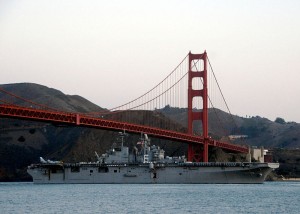 Think again! On October 16, my old New Pacific Institute Pal, Kyle Mizokami, published a particularly eloquent piece, lamenting the defunding of the 2013 San Francisco Fleet Week, entitled “Scrapped: The Naval Parade That Brings Military and Civilians Together” over at medium.com.
Think again! On October 16, my old New Pacific Institute Pal, Kyle Mizokami, published a particularly eloquent piece, lamenting the defunding of the 2013 San Francisco Fleet Week, entitled “Scrapped: The Naval Parade That Brings Military and Civilians Together” over at medium.com.
Two days later, on October 18, the Department of Defense did this, reinstating community outreach efforts.
Hagel’s verbiage echoed Kyle’s:
Even given the austere fiscal climate, Secretary Hagel believes the Defense Department must preserve vital links between service members and communities across the country,” said Pentagon Press Secretary George Little…
…“Community and public outreach is a crucial Departmental activity that reinforces trust and confidence in the United States Military and in its most important asset- people,” Hagel asserted. “It is our obligation to sustain that trust well into the future.”
Not bad, eh?
Interestingly, Kyle has been on Twitter, complaining that his essay was “tanking”, and that while readers were overwhelmingly positive, the eyeballs just weren’t there (that may be because Kyle’s essay was distributed to the Pentagon on several non-linking news distribution lists). So hopefully Kyle will take the Pentagon’s well-timed reintroduction of community service activities as an opportunity to appreciate the relevance of what he does….but, that said, appreciation doesn’t buy ramen–the good folks in the War Is Boring syndicate get paid for the clicks, so please read to Kyle’s great piece if you can. Or send him a note.
Civic outreach is enormously important to both Kyle and I. On my part, I have written widely about the importance of civil-military community outreach–and the importance of the San Francisco Fleet Week as well (full disclosure, Kyle and I both rode in on the USS Makin Island during her Fleet Week visits). Fleet Weeks are important, particularly as the old wide-spread Navy footprint consolidates down to three or for megabases. If you wish, take a look–My old 2007 essay, “Don’t hate San Francisco: Engage, don’t estrange“, focused on San Francisco’s complex relationship with the Navy, and I’ve talked a lot about Fleet Weeks on the blog.
Anyway, Fleet Weeks are more than just an expensive, unjustified celebration. Under the leadership of forward-thinking officers like Vice Admiral Hunt (who, sadly, retires next month), Fleet Weeks have taken on a more operational aspect–the celebration is there, but, underlying it all is the idea that the Navy may need to be working in the port under very different–and far more dire–circumstances. That’s led to a lot of different activities–Osprey landings in various places, tabletop exercises, evacuation drills. It’s a lot more than watching sailors get celebrated and seeing the Blue Angels Flyby…
This is particularly true for the West Coast. No American urban areas are so at risk of a sudden massive regional calamity (i.e. earthquakes) than those on the West Coast. Historically, the military took on a good bit of the immediate disaster response and recovery–but, since the last semi-big one, back in October 17 1989, the Armed Services have contracted. San Francisco will weather the next “big one” on her own (a good video of what the Navy did in 1906 and 1989 is here), until the Navy can get up from San Diego to help.
No matter where the city is, Fleet Weeks serve as a good way to get the right people talking, and to determine how the Navy could get in and help, if required. That’s becoming the “real” purpose behind Fleet Week, and that’s why Fleet Weeks need to remain in the Navy’s operational budget.
So, given how these big maritime celebrations are changing, I hope SECDEF Hagel’s reinstatement of Fleet Weeks marks a sea change in how the Navy views and values their seemingly “old fashioned” harbor parties. Fleet Weeks have a purpose, and they tie directly to some of CNO Greenert’s tenets–Operate Forward and Be Ready. The next big domestic earthquake could happen anytime–and, for much of the nation, the Navy will be the only service positioned to support.

{ 2 comments… read them below or add one }
Good presence, but still, a shadow of what was there in 1989!
Fortunately the Bay Area does still have a relatively large Coast Guard footprint, including an airstation at SFO and the three newest and largest cutters.